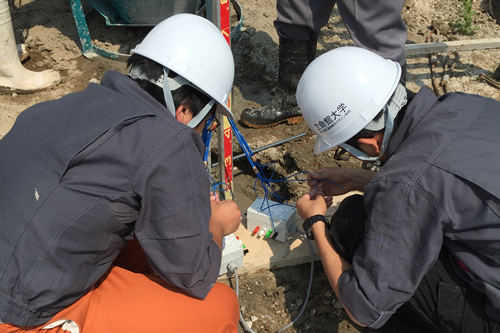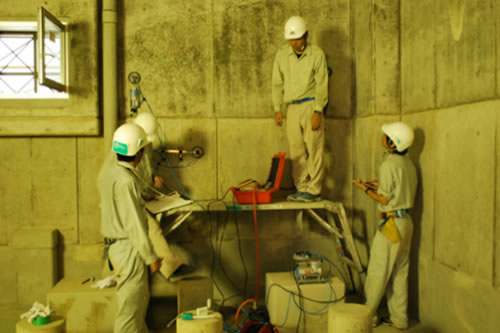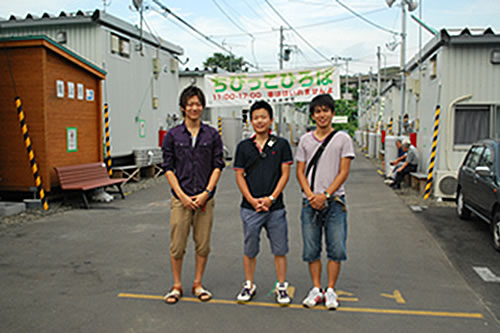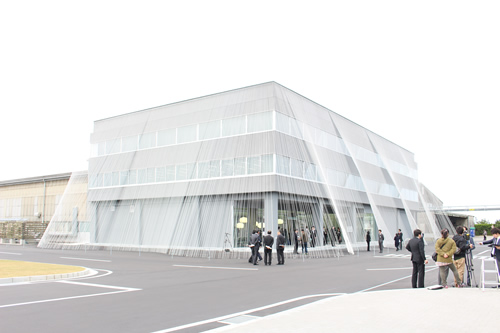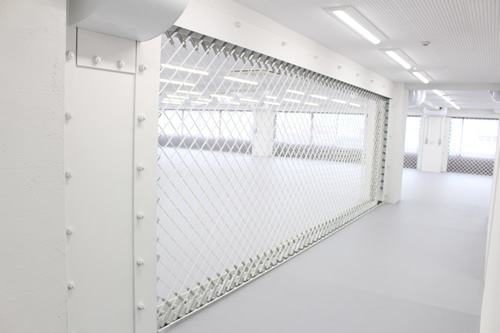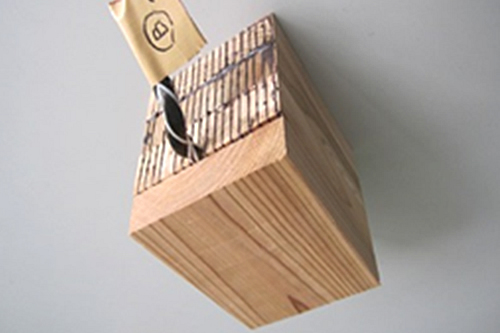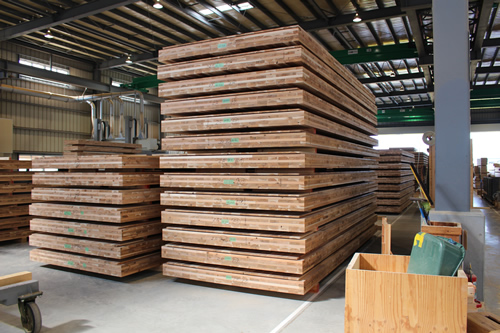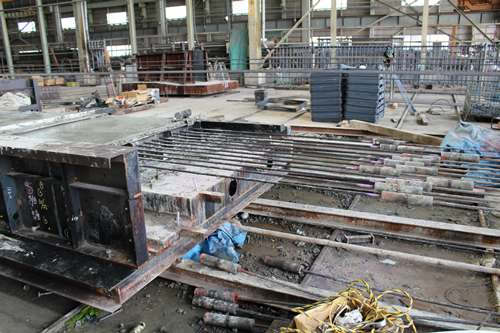Research
Development of construction and quality control methods: Electrical resistivity measurement method
Electrical resistivity (R) is a fundamental property that quantifies how strongly a given material opposes the flow of electric current. Its value describe the electrical resistance (r) of 1 cubic (m2×m) material and calculate by R=r(Ω)×A(m2)/L(m), therefore, the unit is Ω.m. In liquid shape material (e.g., slurry), electrical resistivity value will be in the shortest route of electrical current flow between to adjacent electrodes if an electrical resistivity measurement sensor inserted inside the material, although it is also depends on the sensor shape. This property is different for every material, therefore, it is possible to understand the change of hydration process of composite material that contains both liquid and solid materials. In this research, we are developing characteristics of materials (soil) utilizing the electrical resistivity value and use it as a quality control method in construction management process.
History of research on electrical resistivity measurement method
2021
Research on quality confirmation method immediately after pile construction using resistivity by ICT (radio wave transmission of soil cement in soil)
Development of pile-shaped ground reinforcement method
2020
Research on quality confirmation method immediately after pile construction using electrical resistivity
(underwater radio wave transmission)
2019
Study on Bleeding and Compressive Strength of Cement Milk Added with Baking Soda(Reduction of bleeding and prediction of strength by electrical resistivity)
Study on quality control in fluidized treatment ground improvement method by electric resistivity survey( Application of fluidization processing to completion control value)
2018
Study on Possibility of Construction Management of Ground Improvement by Using Electric resistivity (On the Effect of Early Cracking and Collapse of Pore Wall on Electric Resistivity)
2017
Study on strength prediction of soil cement in embedded pile construction method using electric resistivity measurement (from relationship between material curing age and uniaxial compressive strength in laboratory test)
Study on creation of electrical resistivity measuring instrument and its application (Verification of on site measurement in embedded pile construction method)
2016
Promotion of ICT Utilization by Electric Resistivity Management in Fluidization Treatment Process for Ground Improvement
Study on Quality Control using the Electrical Resistivity of the Cement Milk in Embedded Pile
A Study on Prediction Method of Uniaxial Compressive Strength of Soilcrete Around Pile Perimeter Using Electrical Resistivity Value
Study on construction quality control of soilcrete around pile perimeter Embedded Pile Contruction by electric resistivity measurement
Evaluation method of fine-grain content using electrical resistivity in clay soil
2015
Evaluation of fine grain content of soil by electric logging method
2014
Study on the quality of soilcrete in the pile perimeter of buried pile by electric resistivity measurement in the actual construction site
Study on reservoir decontamination activity using electrical resistivity measurement in the Great East Japan Earthquake
Study on Evaluation of Fine Grain Content of Soil by Electrical Resistivity Measurement on Swedish Sounding Test
2013
Evaluation of Fine Grained content of soil using electrical resistivity measurement method
Study on evaluation of uniaxial compressive strength by wet grab sampling of fluidized process of ground improvement using local soil
Development of fluidization treatment process of ground improvement using cementitious solidifaction material and site soil (part 1, construction and management method)
Development of fluidization treatment process of ground improvement using cementitious solidification material and soil - Uniaxial compressive strength evaluation by wet grab sampling
2012
Development of fluidization treatment process of ground improvement using cementitious solidification material and site soil – quality control method
Development of block shaped fluidization treatment process of ground improvement using cementitious solidification material and site soil
2011
Study on compressive strength and electric resistivity value of ground improvement body in different types of soil
Study on compressive strength and elution amount of hexavalent chromium in ground improvement body using cementitious solidification material and organic soil organic soil
2009
Promotion of ICT in electrical resistivity measurement based quality control of fluidization treatment process of ground improvement
2008
Study on the relationship between electrical resistivity value and mixing degree
2007
Quality control method using electrical resistivity (ground improvement and fluidization treatment process)
Promotion of sustainable design: Seismic isolation retrofit
The seismic isolation retrofit construction method that has been utilized worldwide and currently adopted in many buildings in Japan. Advantage of seismic isolation system is it can maintain the function of buildings after major earthquake and preserve the cultural value of historical buildings. An example of seismic isolation retrofitted building in Japan is the National Museum of Western Art, which is said, was designed based on principle of Le Corbusier ideas. This building contributed to the dissemination of the seismic isolation structure after the Great Hanshin-Awaji Earthquake and realization of sustainability of architectural culture.
In earthquake prone country such as Japan, the cultural and artistic value and architect’s design philosophy can be limited due to strict regulation and standard. Considering this challenges, in our laboratory research, we will verify the relationship between architectural design and structural performance and propose more effective design / construction method etc. from past experience of seismic isolation retrofit.
Seismic isolation retrofit researches
2021
Study on the design method of seismic isolation retrofit of traditional wooden structure
2020
Study on seismic isolation retrofit of wooden buildings
2019
Study on process control of seismic isolation retrofit construction
2018
A study on the steps of the temporary receiving method in the seismic isolation retrofit method
2017
Study on the Structural Performance Approach to the Architectural Design of Modern World Heritage: The Main Building of National Museum of Western Art
Study on the Effect of temporary supporting method on the Quality and Construction Period by in Seismic Isolation Retrofit Project
2015
A study of construction management of seismic isolation retrofit (Dalian)
Study on construction management of seismic isolation retrofit construction: effectiveness of temporary supported method
2014
A characteristic seismic study and development of Earthquake resistant techniques in existing structures (Seoul)
2010
Study on characteristics of construction process of seismic isolation retrofit using underpinning technique-Study case: Seismic Isolation Retrofit of Central Government Building in Hirosaka, Kanazawa)
2005
Study on Noise and Vibration Generated in Seismic Isolation Retrofitting Construction
2003
Study on the vertical properties of underpinning technique in seismic isolation retrofit construction
2002
Behavior of Steel Piles During Jacking (Singapore)
2001
Consideration on construction behavior of press-fit steel pipe pile
Seismic Isolation Retrofit for Preservation and Renovation of the Historic and Important Cultural Building (Singapore)
1998
National Museum of Western Art, Main Building Preservation using Seismic Isolation Retrofit - Structural Design
Plan and outline of the National Museum of Western Art, Main Building Preservation using Seismic Isolation Retrofit
Experimental study on integration of existing building foundation and seismic isolation member
1997
National Museum of Western Art, Main Building Seismic Isolation Retrofit Project
Development of New Construction Materials: Carbon Fiber for Building Material
It is been know that a composite material containing high strength carbon fiber has the higher strength and lighter compare to steel material. However, it is not fully utilized in Japanese construction industry currently. Komatsu Seiren corporation pioneered the first attempt to study the effectiveness of high strength carbon fiber composite material for seismic reinforcement purposes in Japan. They developed rod shaped CFRPT called Fa-bo for this research in 2015. Until now, the development of high-strength fiber material using thermoplastic resin has been conducted with the support of the Ministry of Economy, Trade and Industry. These thermoplastic resin carbon fiber have the advantages in its productivity and high recyclability. Furthermore, the productivity and constructability at the construction site of the high-strength fiber composite material is extremely high and suitable for labor saving. In spite of future development is necessary in view of strength and temperature dependence, the possibilities of its utilization in building construction has a bright future and it is possible to be used in many fields.
Research on Carbon Fiber
2021
Efforts to create design guidelines for FRP structures
2020
Study on structural effectiveness of a buildings structure by using a CFRTP
2019
Study on the effectiveness of a building structure subjected to tensive force(Utilization of thermo-plastics carbon fiber reinforcement)
2018
Development of CFRTP rod using the thermoplastic resin(Study on the joint and twisting performance)
2017
Study on Practical Application of Carbon Fiber Strand Rod Using Thermoplastic Resin (Consideration of Construction Productivity in Case of Seismic Retrofitting)
2016
Development of carbon fiber strand rod using thermoplastic resin · Material performance in experimental products
2014
Development of carbon fiber strand rod using thermoplastic resin
2013
Study on laminated wood with carbon fiber braid added between lamination layers
2012
Development of carbon fiber strand rod using thermoplastic resin
A Study of Carbon Fiber Strand Rod using Thermoplastic Resin
Development of carbon fiber strand rod using thermoplastic resin
2011
Fundamental study on carbon fiber composite material with thermoplastic resin
Another research
Topic: Durability of RC Building
2019-2022
Experimental study on surface performance of precast concrete
2022
Study on repair work of traditional wooden building
Study on conservation plan of large-scale exchange facility for persons with disabilities
2020
Plan to extend the life of buildings affected by external chloride
2019
About development of life extension plan of school facility
2016
Study on the Retrofitting Plan of Superannuated Velodrome
Study on Evaluation of Building Life of Reinforced Concrete Structure Building – Study on Calculation of Physical Life of Building –
Study on evaluation of physical life of reinforced concrete structure building – Building with carbonation and internal chlorination –
2014
Surface quality of actual structure with concrete using expansive additives
2011
Study on Stress Evaluation Method of Expanded Concrete
Strain Behaviors and Occurring Stress of Concrete Materials of Building Using Expanded Concrete
Towards Harmonization of Concrete Building with the Landscape - Material Exposed Concrete Building Group Supporting Japanese Liquor Brewery Building
Topic: Emergency Temporary Building
2015
Study on the Damage Level of Houses After an Earthquake and the Number of Necessary Emergency Temporary Housing Units
2013
Study on the Effect of Green Roof Platform Installation of Steel Emergency Temporary Houses Folding Board at the Great East Japan Earthquake
Study on Supply and Specification of Emergency Temporary Housing in the Great East Japan Earthquake - Through the Heat Insulation and Sound Insulation Material for Building with Folding Roof
Study on Supply and Specification of Emergency Temporary Housing in the Great East Japan Earthquake - Through the Interview Survey and Measurement Monitoring
2012
Exterior heat insulation in temporary housing for earthquake disaster, utilization of sound insulation material - Case study in Natori, Miyagi prefecture
Topic: Building Structure
2019
Study on design method of foundation considering floating
Experimental study on surface performance of precast concrete
2018
Study on seismic performance of seismically isolated building by CLT method
2011
Proposal on Seismic Retrofitting of Building Adjacent to Building with Different Structural Types
Study on Seismic Retrofit of Heterogeneous Buildings using Expansion Joint
Study on the Characteristics of Japanese Tile Construction Method at Nishi Honganji Temple in Kanazawa
2005
Consideration on Seismic Isolation Building Considering Earthquake Ground Motion Generated by Morimoto-Togashi Fault Activity
Study on In-situ Welded Joint of Plastic Area of Beam-Column Joint
1990
Mechanical Properties of Steel Tube Interrupt Separate Type Gusset Plate Joint - Local Stiffening Effect caused by Stiffener Ring -


